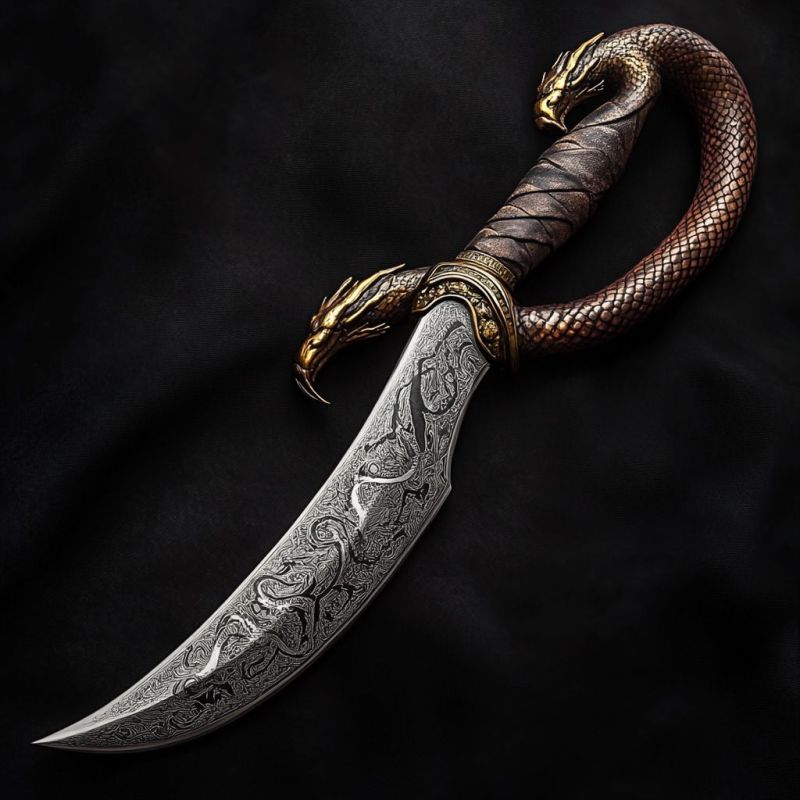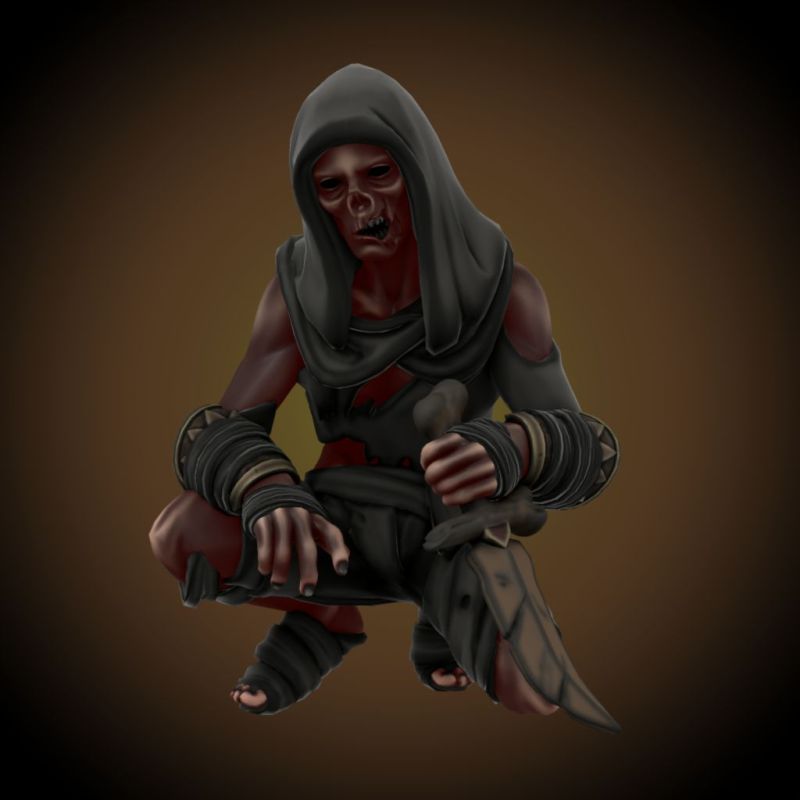
 Inventory Equipped:
Inventory Equipped:-
Dagger of Venom38502 gp
 Natural Armor:
Natural Armor:-
Natural Armor +30 gp
 Natural Weapon(s):
Natural Weapon(s):-
Claw (2d4)
 Passive Abilities:
Passive Abilities:-
Extra Weapon Damage - Poison (2d6)37500 gp
-
Weapon Enchantment +11000 gp
 Attack Abilities:
Attack Abilities:-
Paralyzing Attack1200 gp
 Free Abilities:
Free Abilities:-
Agonizing Gaze
 Monster Bits:
Monster Bits:-
25 Animal Bone0.03 gp
-
6 Necrotic Essence2 gp
-
25 Rotten Flesh0.05 gp
This withered creature wrapped in gore-stained rags. They can pull back a tattered hood to reveal glowing eyes hungry with bloodlust.
💀👹 Angatra: The Vengeful Ancestor
The angatra is a horrifying embodiment of retribution, born from the cursed soul of a tribal leader or elder who defied sacred taboos. 🖤 Exiled and executed, their spirit festers in a decaying body, bound by ritual cloth and sealed in a forgotten tomb. When these bindings are neglected or desecrated, the angatra rises—a withered, claw-wielding terror driven by wrath to hunt its own kin. Its presence is a chilling reminder of the price of betrayal, its malice a curse that stains the living and the dead alike.
⚰️ Origins: Born of Taboo and Banishment
Angatra arise from the violation of sacred tribal laws, their genesis tied to the disgrace of those who held power. 🪦 A leader or elder who breaks a taboo faces exile, execution, and a curse that binds their spirit to their corpse. Wrapped in lamba cloth and entombed far from sacred burial grounds, their soul is meant to be soothed through ritual. But if these rites falter or their tomb is disturbed, the spirit’s torment festers, birthing an angatra. Game Masters can root these origins in a campaign’s culture, perhaps tied to a tribe’s ancient pact with a vengeful deity or a cursed bloodline.
🕸️ Bound Remains: Entombed in Shame
The body of the accursed is meticulously prepared to contain its restless spirit. 🧵 Swathed in lamba cloth to pacify the soul, it is sealed in a remote tomb, far from ancestral graves to prevent corruption of the sacred dead. This isolation is both punishment and precaution, ensuring the spirit’s malice cannot taint the living. GMs can design these tombs as eerie set pieces—crumbling crypts filled with faded runes, hidden in desolate wastes, or guarded by tribal wards that hint at the horror within.
🕯️ Slow Ritual Cleansing: Atonement Over Ages
Every decade, the tribe performs the famadihana ritual, replacing the lamba bindings and chanting to ease the ancestor’s suffering. 🙏 Over generations, this rite cleanses the cursed soul, eventually granting it passage to the afterlife. But if descendants abandon this duty or the tomb is violated, the spirit’s anguish erupts, transforming the corpse into an angatra. GMs can use this ritual as a narrative hook, perhaps tasking players with protecting a famadihana ceremony or investigating why a tribe ceased their duties, unleashing the horror within.
😡 Angry Spirit: A Metamorphosis of Malice
When freed, the angatra’s corpse undergoes a grotesque transformation. 🦂 Its fingernails elongate into scabrous claws, its skin hardens into leathery hide, and its withered frame gains unnatural speed and agility. Tearing through its lamba bindings, the angatra emerges as a predator driven by vengeance, its decayed form a mockery of its former self. It hunts its descendants with relentless fury, seeking to inflict the torment it endured. GMs can emphasize this horror, describing the angatra’s ragged appearance and eerie grace as it stalks its prey through shadowed lands.
⚔️ Relentless Pursuit: Torment of the Living
The angatra’s wrath is singular—targeting its own bloodline to share its cursed suffering. 🌑 With supernatural speed, it stalks through villages or wilderness, its claws rending flesh and its presence sowing dread. Its attacks are not random but calculated, striking at descendants with precision that speaks of ancient grudges. In combat, its agility makes it a deadly foe, dodging blows while delivering savage strikes. GMs can craft encounters where players must protect a village from an angatra’s wrath or trace its origins to break its curse.
🪄 Supernatural Resilience: A Curse Unbroken
The angatra’s cursed nature grants it unnatural vitality. 🛡️ Its leathery hide deflects mundane weapons, and its spirit-fueled body shrugs off wounds that would fell mortals. Only specific rituals—often tied to the tribe’s traditions or the original taboo—can permanently destroy it. Fire, sacred relics, or a restored famadihana ritual might weaken its curse, but such secrets are buried in tribal lore. GMs can create quests to uncover these vulnerabilities, forcing players to delve into ancient texts or seek out tribal elders for answers.
🏚️ The Angatra’s Lair: A Tomb of Vengeance
An angatra’s lair is its desecrated tomb, a place of decay and broken wards. 🪨 Strewn with tattered lamba cloth and shattered stone, it radiates an aura of malice that chills the soul. The tomb may lie hidden in a cursed valley or beneath a tribal settlement, its entrance marked by warnings in forgotten tongues. GMs can design the lair as a claustrophobic dungeon, filled with traps left by the tribe and echoes of the angatra’s torment, making exploration as perilous as the creature itself.
🗝️ Confronting the Angatra: Atonement or Annihilation
Facing an angatra is a trial of courage and cunning. ⚡ Heroes must unravel the history of its curse, perhaps seeking out surviving descendants or lost rituals to quell its wrath. Combat is a desperate struggle against its speed and resilience, but true victory lies in breaking the curse—restoring the famadihana, reconsecrating the tomb, or appeasing the spirit with a selfless act. Failure risks joining the angatra’s victims, their bones added to its lair. GMs can craft these encounters as moral dilemmas, blending combat with roleplay to resolve the ancestor’s pain.
🌑 Apex of Ancestral Wrath
The angatra is a tragic terror, a once-honored soul twisted by betrayal and neglect. 💔 In worlds where tribal bonds and ancient taboos hold sway, it is a specter of consequence, its claws a reminder of the cost of forsaking tradition. Whether haunting a remote village or stalking a campaign’s heroes, the angatra challenges players to confront the sins of the past. Only those who can unravel its curse and restore its peace will end its reign of vengeance, freeing both the living and the dead from its unrelenting fury. 🖤
Environment:
![]()
🌍🤺 Humans: Weavers of Destiny
Humans are Zin’s vibrant and adaptable race, their kaleidoscope of forms and ambitions threading through the world’s grand tapestry. 🌟 With diverse appearances and boundless drive, they shape civilizations, conquer challenges, and leave enduring legacies. Resilient and versatile, humans thrive in every corner of the realm, their short lives burning bright with innovation and courage, making them a force that reshapes history with every step.
🎭 The World’s Mosaic: Diverse and Dynamic
Humans embody a stunning array of heights, weights, and skin tones, each a unique stroke in Zin’s cultural canvas. 🧑🤝🧑 Standing 5 to 6 feet tall and weighing 100 to 200 pounds, their varied looks—dark curls, golden skin, or piercing eyes—reflect their adaptability. This diversity fuels their ability to flourish in deserts, forests, or cities. GMs can highlight their individuality, describing unique attire or quirks to showcase their multifaceted nature in vibrant roleplay.
🏰 Builders of Legacy: Architects of Eternity
Humans craft magnificent cities, from towering spires to sprawling ports, designed to outlast their fleeting lives. 🏛️ Governed by hereditary lines or enduring councils, these societies enshrine tradition and ambition, weaving heritage into stone. Their drive for legacy shapes Zin’s history, leaving monuments that echo for centuries. GMs can use human cities as campaign hubs, filled with political intrigue, ancient relics, or quests to uphold a family’s honor.
🛠️ A Well of Versatility: Masters of All Trades
Humans are Zin’s ultimate adventurers, their innate flexibility allowing them to excel as warriors, mages, rogues, or diplomats. ⚔️ They adapt swiftly, learning new skills or shifting roles as challenges arise, their quick minds solving problems with ingenuity. GMs can emphasize their versatility by crafting scenarios where humans pivot from combat to diplomacy, showcasing their ability to thrive in any situation.
🚀 Pushing the Boundaries: Trailblazers of the Unknown
Driven by relentless ambition, humans venture into uncharted lands, from perilous jungles to arcane ruins, seeking glory or knowledge. 🌌 Their risk-taking fuels exploration and innovation, often leading revolutions or discoveries that redefine Zin. GMs can cast humans as bold pioneers, with players leading expeditions or challenging ancient powers, their actions rippling across the world.
🏆 A Force to Be Reckoned With: Enduring Impact
Though short-lived compared to elves or dwarves, humans build institutions—empires, guilds, or temples—that endure beyond their years. 🏰 Their resilience and collective ambition make them a formidable presence, shaping Zin’s fate through sheer will. GMs can portray humans as catalysts for change, their cities or heroes driving campaigns toward epic conflicts or grand alliances.
🏞️ The Human’s Domain: Cities of Ambition
Humans dwell in bustling metropolises or hardy frontier towns, their homes reflecting their diverse cultures—ornate marble halls, wooden longhouses, or desert bazaars. 🌆 These settlements buzz with trade, intrigue, and innovation, often fortified by walls or diplomacy. GMs can design human domains as vibrant stages, where players navigate bustling markets, political schemes, or ancient ruins beneath city streets.
⚔️ Confronting Humans: Clash of Wills
Engaging humans tests adaptability, as their diverse skills make them unpredictable foes or allies. 🗡️ Warriors wield steel, mages conjure spells, and diplomats sway hearts, requiring tailored strategies to counter. Their ambition can be exploited—luring them with glory or treasure—but their resilience demands respect. GMs can craft encounters as multifaceted challenges, blending combat, negotiation, or intrigue to reflect human versatility.
🌌 Flame of Boundless Ambition
Humans are Zin’s radiant spark, their diverse threads weaving a saga of resilience and daring that lights the world’s path. 🌍 From building empires to braving the unknown, they embody the relentless pulse of progress, their ambition a fire that shapes destinies. Whether forging peace or seeking glory, they challenge heroes to embrace their own potential, crafting tales that echo through the ages in the ever-evolving tapestry of existence.
-
 Speed:
Speed:
-
 Walking Speed:
+30
Walking Speed:
+30
 Skill Tier 1:
Skill Tier 1:-
 Common Language Skill
Common Language Skill
 Random Name Table Male
Random Name Table Male-
Names - Human - Male - First
 Random Name Table Female
Random Name Table Female-
Names - Human - Female - First
 Random Name Table Last Name
Random Name Table Last Name-
Names - Human - English - Last
